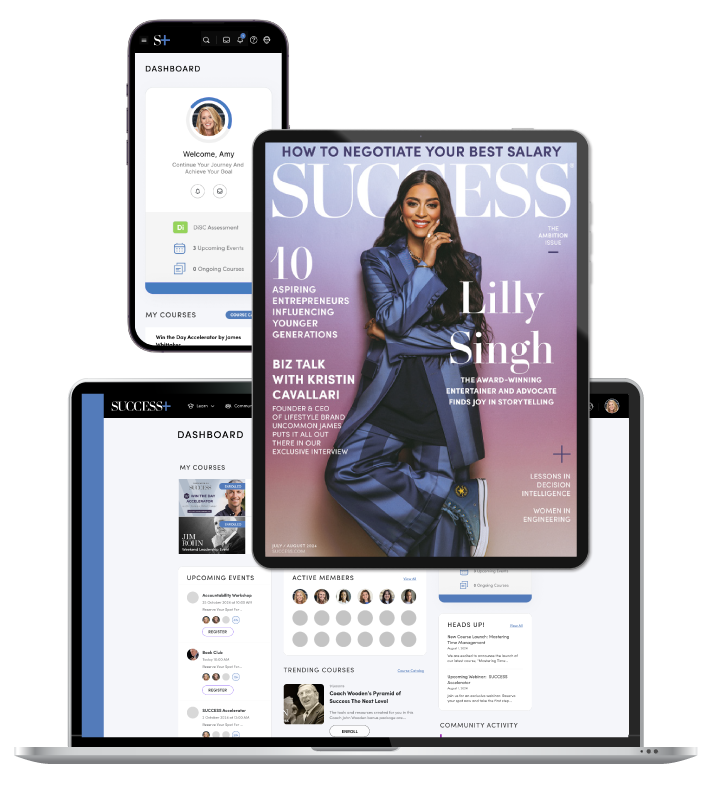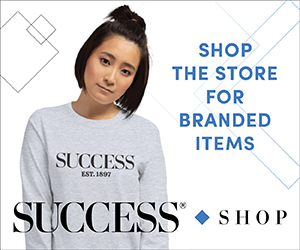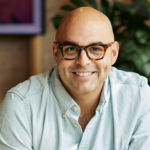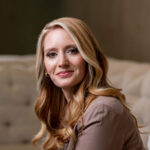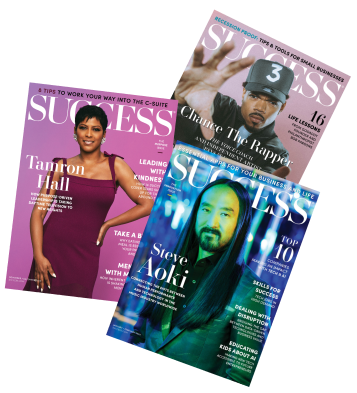This Q&A is adapted from a podcast episode of Unscripted With Amy Somerville. Listen to the full episode here.
Courtland Warren, thought leader, master facilitator and SUCCESS® Leadership Lab expert, has dedicated his career to helping individuals and organizations unlock their potential and create meaningful change.
SUCCESS® CEO Amy Somerville interviewed Warren about true transformation, learning how to shift from fear to purposeful action and releasing limiting beliefs.
Amy Somerville: “Transformation” is truly one of my favorite words. What does transformation mean to you? And what is the first step someone should take when they are feeling stuck?
Courtland Warren: People often confuse transformation with change. It’s about understanding that those are two completely different things. Like when something has changed, it can go back to what it was. Seasons change, style changes, fashion changes. But when something is transformed, it can’t go back. It literally changes the form of. So when we talk about transformation, it’s about recognizing that you become something never to return to what you were.
So if I were to say: a caterpillar to a butterfly. Is that change or transformation? Transformation. A lump of coal to a diamond. Is that change or transformation? It’s transformation. So first, it’s about knowing that you’ll never be the same; you won’t be who you were. And when it comes to that first step, it’s awareness. Where am I? Where do I find myself? What options are available?
I often say that choice is a function of awareness. I can’t judge you for the choices that you made until I know what options you were aware of. So if you find yourself stuck and you’re looking for transformation, it’s about first creating a level of awareness that allows that.
AS: You have been helping people transform their lives for years. Would you take a step back and tell us a little bit about your history and the moment that inspired you to step into this work?
CW: I’m the kid who, believe it or not, would cry in church when it was time to give the Easter speech. Year after year, I would promise myself that I was going to do better, and my mom would have to come and usher me off. But I finally got it. That’s where I first started to believe I could speak in front of a group.
When I was in middle school or high school, we switched churches. Now I’m not a minister or pastor or anything like that, but that’s where it started. I then got experience speaking to different audiences, audiences that didn’t always look like me, so that’s where the belief started.
I won’t say that I always believed in myself, but I was in a position where I could borrow someone else’s belief in me. When a particular person who I respected and admired said, “You could do this,” I believed them. I don’t always believe, but I find that I don’t have to have the belief before I get started. I don’t have to have the fear removed before I start, but the action replaces the fear over time. It was a combination of being willing to take the action, as well as advocates who said, “You can do it.” I was able to borrow their belief in me, and that’s really where it got going.
AS: What’s one question or challenge that you pose to your coaching clients that shifts their perspectives in a big way?
CW: I oftentimes will ask them: What’s the benefit or the payoff that you’re getting for the current belief? We’re oftentimes looking at the limiting beliefs, so it’s a pattern interrupt of sorts. You’re holding onto this belief of, “I’m not good enough,” or “I’m not smart enough,” or “I don’t have the look,” or “I don’t know the right people. I’m not ready yet.” When I ask, “What’s the benefit or the payoff that you get from that belief?” they say there is no benefit.
I remind them that just because I say “benefit” doesn’t necessarily mean that it’s a positive. Then they start to explore it and realize: “I get to remain safe, I get comfort, I get someone else to blame, I get a reason why not.” So in my experience, when we start to identify the benefits or the payoffs, we recognize that we’re not just doing it—there’s a need that is being served.
So it’s important to identify the need that’s being served, then the payoff and then we can look at the price. What does it cost you? In my experience, if we invert those questions to first see that there is a need being served in holding onto the belief, then we can explore the prices of it.
AS: You recently posted something that really hit home with me, and I think it may be tied to this concept that we’re discussing. It was a post about holding space for others and allowing others to hold space for you. You said at the end of the post, “The work of unburdening is, at its core, the work of becoming.” What does that mean to you?
CW: So often in my life I felt like there was something wrong, that something needed to be fixed, that I was somehow damaged, broken, something was missing, and what I’ve come to know is that in those burdens, a lesson or message was always revealed. The lesson was always in that part of me that I was unwilling to embrace.
John Demartini says, in those disowned parts, the parts of me that I wished were different, were actually the parts that revealed what I was disowning or what I needed to love. I was seeking an answer and didn’t realize that it was on the other side of that which I was most resistant to. So when I say that unburdening is about becoming, it’s really about wholeness, no fragmented parts.
The word integrity comes from the term “integer.” An integer in math is a whole number. So when we talk about being in integrity, it’s about being whole, to embrace all sides—what some might call the shadow or dark or whatever. But the mistakes that I’ve made, the regrets that I have, the guilt that I feel for missed opportunities, squandered relationships or whatever, I find there was a lesson there that I was ignoring as long as I was unwilling to look. The idea of unburdening or laying those burdens down was really about showing some self-compassion and love for myself in a way that I was willing to embrace all aspects, embrace all the sides of myself and not feel as though I had to show up perfectly or in a way that was for the approval and acceptance of others. And the more I’ve begun to do that, the more I attract opportunities and people, like yourself. That is the work of becoming. It’s really about embracing all of it.
AS: All of it—the good, the bad, the ugly—and recognizing that is what you’re supposed to be.
CW: That’s how I see it. The law of polarity says that in order for anything to exist, the opposite must exist also, so you can’t have an up without a down. You can’t have in without out. You can’t have positive without negative. We wouldn’t know light without some dark. And so in order for anything to exist, you must also have the opposite.
Often when it comes to success and achievement, we’re looking for the book, the coach, the podcast that reveals how we can do it without making a mistake or how we can do it without any failures, and it’s chasing fantasy. I think we’re much more effective if we create environments where it’s safe to fail, rather than a fail-safe environment.
The idea that I can have success without bouts of adversity and challenge doesn’t work. Believe it or not, I used to really think that if it was hard or if it was difficult, then it wasn’t meant for me. I thought things were just supposed to flow, and I should just allow it to happen effortlessly. When it didn’t happen, I thought, “OK. It must not be my time yet. It must not be for me.” But that’s an escapism-type theology.
Now I recognize that what separates the deserving from the undeserving is the willingness to go through what’s required—not just what I can, but what is required.
AS: You are clearly incredibly self-aware. Do you think, as we’re talking about self-awareness and your ability to be vulnerable, has it been key to your personal and professional success?
CW: Yes! It has been, and if I’m being completely transparent, it’s a new place for me. I haven’t always been willing to embrace the parts of Courtland that are imperfect. There’s a term— “wabi-sabi”—which means perfectly imperfect. I thought perfection was required. I thought what was showing up in a particular way was required.
I grew up in southeast Oklahoma, a little town called Idabel, about 5,000 people. Idabel is a very black and white town, and by that, I mean the railroads separate this town. You have the east side and west side. Black people lived on one side of the town, and white people lived on the other side of town. So growing up, it felt like there were the “haves” and the “have nots,” and we were in the have not line.
I wanted to be able to change lines. What I didn’t recognize, though, was that changing lines became adapting to a world, or at least an interpretation, where I didn’t believe that being me was OK. I thought that I had to be different in order to get those things. Now my mom would say, “We don’t need all that.” She would say, “All we need is love.” But why do I have to choose one or the other? Can we have love and some stuff? So what I morphed into was a version that I thought was acceptable and, therefore, mechanically, when it came to speaking and presentations, even facilitating. It would be mechanically flawless.
I dotted all the i’s, crossed all the t’s. I made all the points; I memorized the script. It was all there, but no one would move. No one would move forward. There was no resonance, and I couldn’t figure it out. I finally decided I would be more real about it, share more of me, share more of the stories, share more of the imperfections. I wanted my life to be a testament of trial and error and bouncing back.
One of my favorite words is “resilience,” which simply is the measure of bouncing back. How quickly can you bounce back from adversity and challenge? It’s helped; it’s been an absolute key. More than that, it’s been freeing to just embrace and love myself so much that I don’t fear the rejection of someone else.
AS: How do you define true leadership? What do you think is the single most underrated skill leaders need in order to succeed today?
CW: When I think about leadership, I associate leadership with the word “power.” The word “power,” by definition, is the capacity to cause movement. Think about an automobile: They measure horsepower. If we say an individual is powerful, by definition, what we’re really speaking about is this person displays the ability to cause movement, whether that’s with people, places or things. Someone is displaying power when they can cause movement in themselves and/or in other people.
If I say that Amy Somerville is powerful, then that means that there has been a display—whether that’s in business, in relationships, connections, podcast success, SUCCESS® magazine—whatever it is, there was the place that it was before Amy showed up, and there’s the place that it has grown or evolved into. That’s leadership, and power is required.
The skill that I think is most underrated and that is absolutely necessary is communication. And, specifically, I think one of the most powerful things in the world is to be able to use your words in such a way that it causes other people to take action for reasons that benefit them. Being able to master language and words in such a way that when you speak them, people are moved—they’re inspired to do something different.
AS: You told me an incredible story about your childhood… about great business books and your following of a success mindset since you were young. Are you willing to share that story with our readers?
CW: Growing up, it was me, my mom and my sister. My dad wasn’t around, and a lot of my life was about how do I win his approval? I worked hard enough to make really good grades. It wasn’t because I was super intelligent; it was more because whenever I would speak to him he would ask about my grades, and I wanted to have a good report. That was my motivation.
My dad installed glass and windows in residential and commercial buildings, and one day, he mentioned that whenever he would go into the largest homes, they always had libraries. I asked what kind of books were in these libraries, and my dad said he didn’t know, but he’d find out. “I’ll start paying attention,” he said.
Fast forward to my sophomore year in high school, and we made it to the state track meet. My dad came to the meet, and afterward, he said he had a gift for me. This was the first time I ever remember receiving a gift from him, and I was excited.
We walked up to the back of his work truck, and he lifted out a green milk crate. It was filled with books for me. None of my teammates understood why I was so excited about these books, so while they talked and celebrated winning the state tournament, I started going through this milk crate. There was Think and Grow Rich by Napoleon Hill. There was Les Brown’s It’s Not Over Until I Win. There was Norman Vincent Peale’s The Power of Positive Thinking. I remember opening up Dale Carnegie’s How to Win Friends and Influence People and “you’ll attract more bees with honey than vinegar.” I’m looking at these and thinking, “This must be how people get those houses he was talking about,” so I started connecting these things together.
About four hours later, we get home, and my mom is like, “Where’d those books come from?” I said, “Daddy gave them to me. He came to the track meet.” She didn’t even bat an eye. She was like, “Get them out of here! I don’t want them in my house. That’s all he did. All he did was read those books and read those books and never did anything with it.”
My grandma lived just behind us, so I walked through a little trail, and I took them there. She had this blue tarp just laying out by her garden, and I took the tarp and wrapped it around that crate of books because in that four hours from the track meet to home, I didn’t know what my dad had done, but I knew what I was reading.
It was unlike anything I had ever learned in school. It was the first time that someone even proposed the idea that you could change your life by changing how you think. Even though my mom was angry, and I was definitely not a disobedient kid, I knew that I was not throwing those books away.
There was a truth there that I wasn’t going to let go of. I understood what my mom was saying. In her resentment, she also revealed a key. She revealed a lesson in that my dad would read the books, but there wasn’t the application or the implementation.
I realized it’s not that the information is wrong. It’s a message of “go do what it says.” And from that, I started to facilitate and speak around those concepts.
AS: You mentioned that just because you read content that inspires, it doesn’t necessarily mean it leads to action. In regard to taking action and the fear or insecurity that might hold us back, what are your go-to strategies for helping people push past those roadblocks?
CW: I’ve been really frustrated with that topic over the last 20 years of speaking and training and personal development. Why is it that some act and others don’t? And it turns out it’s actually in our biology. Our brains have not evolved very much over the last 100,000 years. It definitely hasn’t evolved as fast as technology has. There’s a part of the brain called the basal ganglia, which is that part of our brain that really likes to have things be automatic. You know, tying your shoe, writing your name, getting to that place where it’s just automatic, and habits are formed and entrenched that way. What happens is this: That basal ganglia’s job is to conserve energy. It doesn’t want to expend energy, and therefore, anything that it perceives as requiring too much energy, it will assist us in justifying not doing it. That part of the brain wants to have things be automatic, which is great for forming habits and conserving energy. But man, it is devilish when it comes to change because it interprets change as being too much of an expenditure of energy.
It’s like when NASA builds a rocket. If the goal or the objective is orbiting outer space, that rocket has to get up to 25,000 miles per hour to break the gravitational pull. Eighty to 90% of its fuel gets used just to get outside of gravitational pull. Humans have “habit gravity.” We have habits that are like a force pulling against us, and we just have to embrace that in order to have what we want. Then there is a period of time where more expenditure, more focus, more discipline is required because we have to convince our brain that this new thing is really what we want.
AS: Resilience is really important to pushing past habit gravity. How do you help people cultivate resilience?
CW: Resilience just measures your ability to bounce back from challenges, to bounce back from adversity. We can’t set up life in a way where we won’t have obstacles, where we won’t have challenges. That’s a fantasy. So then, what do we do? If I know adversity is coming, then how do I address it?
Martin Seligman at the University of Pennsylvania has determined that the key to building resilience is in our explanatory style. The three P’s of explanatory style are personal, pervasive and permanence. The research shows that highly resilient people don’t take things personally. Secondly, highly resilient people don’t allow the challenge to be pervasive, meaning cancerous, where it spreads to all areas. Then the third P is permanence. Those with low resilience always see the roadblocks in their life and think, “We’ll never get through this.” Whereas highly resilient people see it as a bump in the road. They see it as something short-lived. So those three P’s—personal, pervasive and permanence—are the way.
AS: What’s on the horizon for you as you continue this work? How do you define success?
CW: I define success as the ability to give myself a command and then follow it. I want the relationship with myself to be so that when I say I’m going to do something, I get it done.
I just want to simply look in the mirror and be proud of who I’ve become. That’s the mission right now: to know that I can look in the mirror and see myself as a worthy expression of what I was meant to be. That’s my pursuit.
If you’re ready to become an influential leader, join the SUCCESS® Leadership Lab where Warren presents “Build and Mentor Your Dream Team,” a lesson on using mentorship frameworks to attract, coach and develop team members with clarity and care.
Warren is one of 10 experts in this 18-day virtual course for rising leaders who want to lead with clarity, influence and confidence. The hybrid experience combines expert-led lessons with live coaching to provide you with practical tools to build trust with your team, navigate chaos and crises, shape a healthy, driven work culture and more. Click here to register.
Photo by Jacob Lund/Shutterstock
